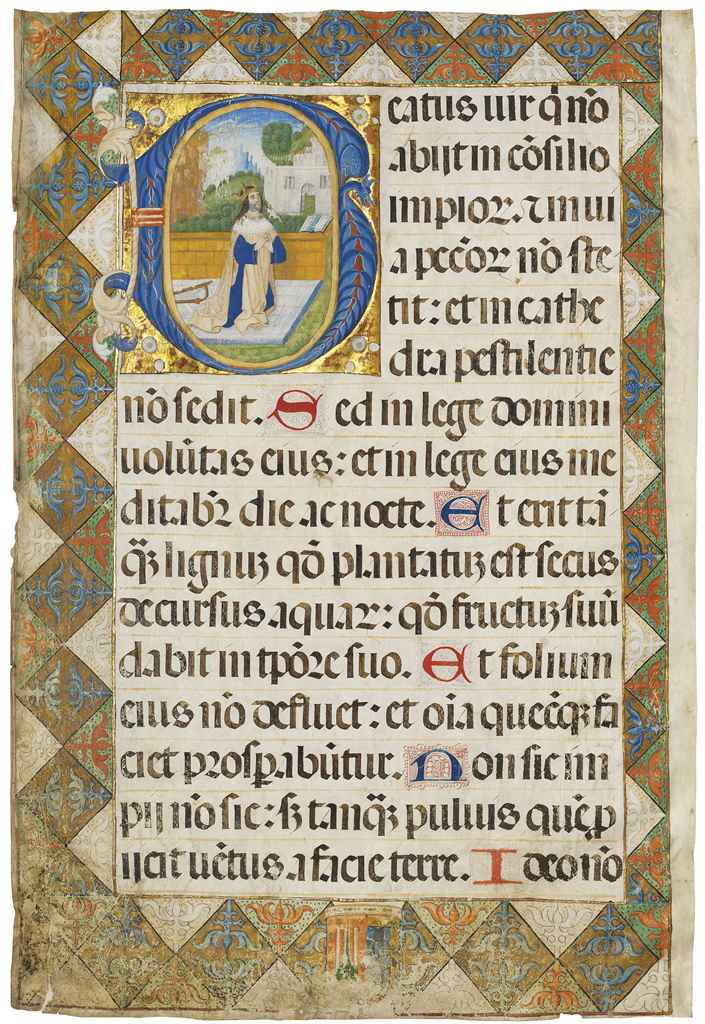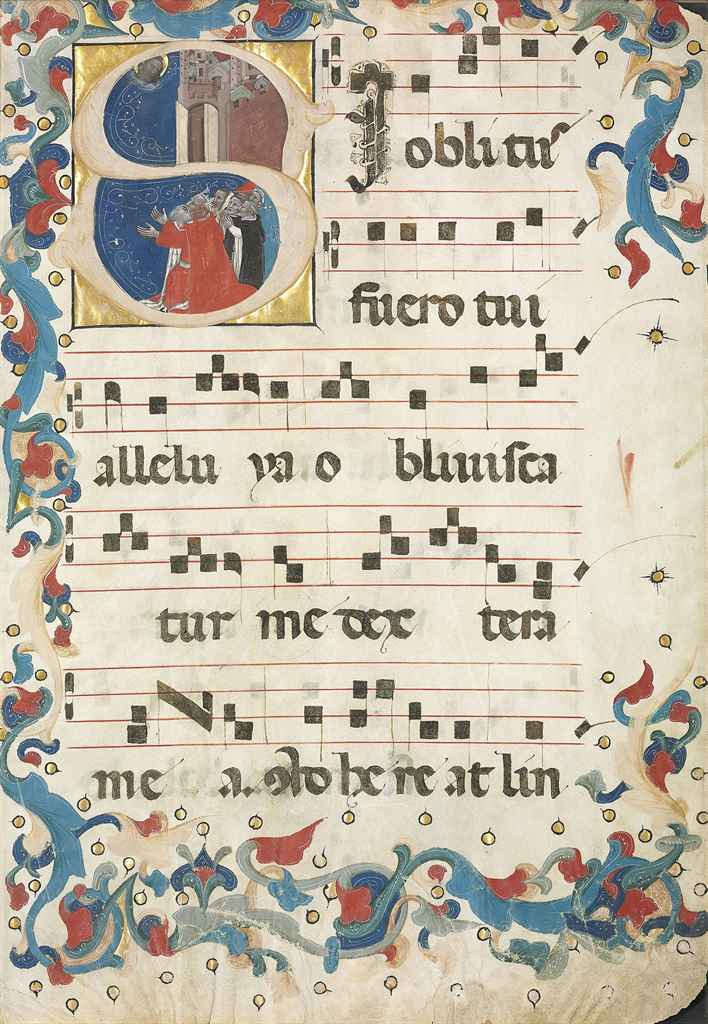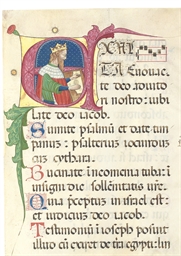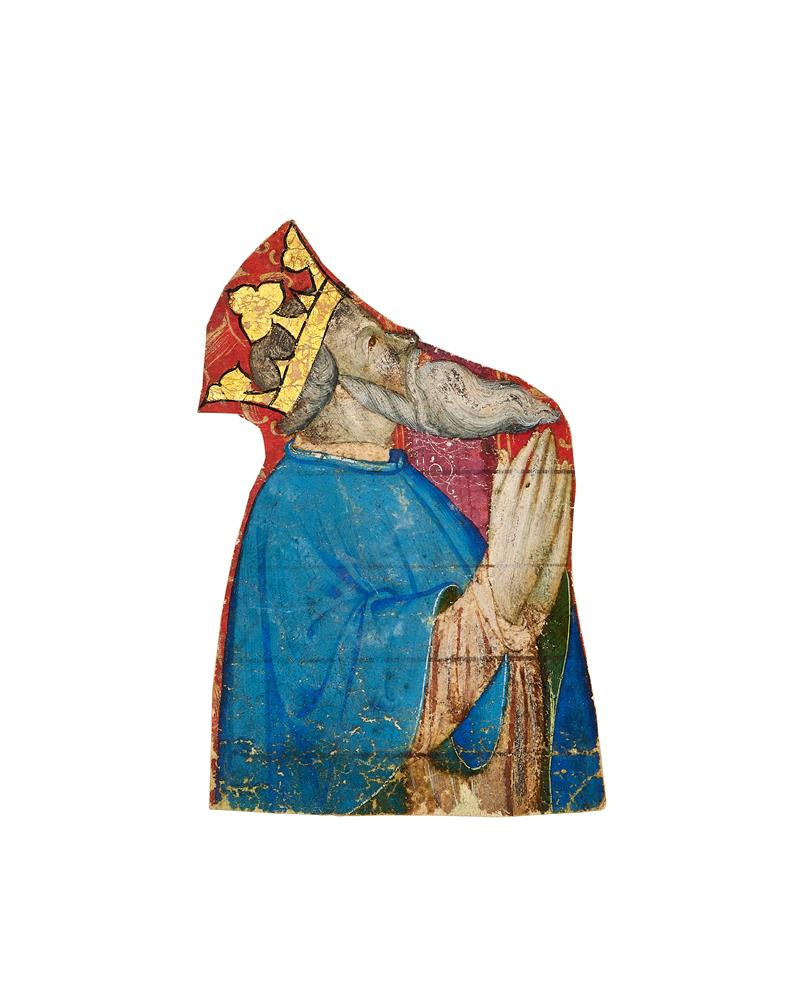KING DAVID IN THE WATERS BLESSED BY GOD, in a historiated initial on one of two leaves from ‘the St Albans Bible’, in Latin, illuminated manuscript on vellum [Paris, c.1320–40] Two very fine leaves from an important period of Parisian illumination, from a Bible almost certainly owned by St Albans Abbey: reputed to have been commissioned by Richard de Bury (Bishop of Durham and author of the Philobiblon ) and owned by Michael de Mentmore, Abbot of St Albans. Two leaves, each c.295×195mm, ruled in pale brown ink for 2 columns of 46 lines written in a very fine, compressed, bookhand, ruled space c.190×125mm, the text of the first leaf comprising Psalms 64:6–68:14, each psalm with a titulus in red, illuminated with a large historiated initial depicting God blessing and King David in the waters, the text of the second leaf comprising Exodus 15:27–18:10, illuminated with the 2-line initials and borders at the chapter divisions (minor darkening at the edges, slight cockling, but generally in very good condition). Bound in grey buckram at the Quaritch bindery. Provenance : (1) ‘From an important Bible illuminated possibly for Richard de Bury [d.1345] author of the Philobiblon , and almost certainly given to St. Albans Abbey by Michael de Mentmore [Abbot of St Albans] who died of the Black Death in April 1349’ (Sotheby’s, 25 April 1983, lot 87; for further detail see C. de Hamel in Fine Books and Book Collecting […], 1981, pp.10–12); until 1964 the volume was in a binding that incorporated fragments of a Register of John Whethamstede (d.1465), Abbot of St Albans. (2) Sold as ‘The Property of a Lady’ at Sotheby’s, 6 July 1964, lot 239; bought by: (3) Philip Duschnes for £1,500 (broken by him, with leaves offered in his catalogues from 1965 onwards). (4) Bernard Quaritch, Bookhands V, cat. 1147 (1991), no 22 (the Exodus leaf). (5) Schøyen Collection, MS 649. Script : This is a very regular, high-grade, gothic bookhand, with occasional calligraphic cadels on the top lines. There are relatively few (time- and space-saving) abbreviations, and individual letters are well-spaced enough that it was not seen as necessary to dot the letter ‘i’ except when flanked by other minims; crossed tironian ‘et’ is used to the exclusion of the ampersand, pairs of round letters (‘os’, ‘ds’, ‘og’, etc.) are usually fused and many other letters ‘kiss’. Text leaves appear on the market frequently, but fewer than a dozen with historiated initials have been identified (all but about 30 had already been excised by the early 20th century); a detailed discussion of the manuscript is in the forthcoming catalogue of the McCarthy Collection. Illumination : The style of illumination is that of the workshop of Jean Pucelle (c.1300-1355), one of the most influential, prolific, and innovative artists of the first half of the 14th century, responsible for such monuments of French illumination as the Belleville Breviary, the Hours of Jeanne d’Evreux and the Billyng Bible.
KING DAVID IN THE WATERS BLESSED BY GOD, in a historiated initial on one of two leaves from ‘the St Albans Bible’, in Latin, illuminated manuscript on vellum [Paris, c.1320–40] Two very fine leaves from an important period of Parisian illumination, from a Bible almost certainly owned by St Albans Abbey: reputed to have been commissioned by Richard de Bury (Bishop of Durham and author of the Philobiblon ) and owned by Michael de Mentmore, Abbot of St Albans. Two leaves, each c.295×195mm, ruled in pale brown ink for 2 columns of 46 lines written in a very fine, compressed, bookhand, ruled space c.190×125mm, the text of the first leaf comprising Psalms 64:6–68:14, each psalm with a titulus in red, illuminated with a large historiated initial depicting God blessing and King David in the waters, the text of the second leaf comprising Exodus 15:27–18:10, illuminated with the 2-line initials and borders at the chapter divisions (minor darkening at the edges, slight cockling, but generally in very good condition). Bound in grey buckram at the Quaritch bindery. Provenance : (1) ‘From an important Bible illuminated possibly for Richard de Bury [d.1345] author of the Philobiblon , and almost certainly given to St. Albans Abbey by Michael de Mentmore [Abbot of St Albans] who died of the Black Death in April 1349’ (Sotheby’s, 25 April 1983, lot 87; for further detail see C. de Hamel in Fine Books and Book Collecting […], 1981, pp.10–12); until 1964 the volume was in a binding that incorporated fragments of a Register of John Whethamstede (d.1465), Abbot of St Albans. (2) Sold as ‘The Property of a Lady’ at Sotheby’s, 6 July 1964, lot 239; bought by: (3) Philip Duschnes for £1,500 (broken by him, with leaves offered in his catalogues from 1965 onwards). (4) Bernard Quaritch, Bookhands V, cat. 1147 (1991), no 22 (the Exodus leaf). (5) Schøyen Collection, MS 649. Script : This is a very regular, high-grade, gothic bookhand, with occasional calligraphic cadels on the top lines. There are relatively few (time- and space-saving) abbreviations, and individual letters are well-spaced enough that it was not seen as necessary to dot the letter ‘i’ except when flanked by other minims; crossed tironian ‘et’ is used to the exclusion of the ampersand, pairs of round letters (‘os’, ‘ds’, ‘og’, etc.) are usually fused and many other letters ‘kiss’. Text leaves appear on the market frequently, but fewer than a dozen with historiated initials have been identified (all but about 30 had already been excised by the early 20th century); a detailed discussion of the manuscript is in the forthcoming catalogue of the McCarthy Collection. Illumination : The style of illumination is that of the workshop of Jean Pucelle (c.1300-1355), one of the most influential, prolific, and innovative artists of the first half of the 14th century, responsible for such monuments of French illumination as the Belleville Breviary, the Hours of Jeanne d’Evreux and the Billyng Bible.













Testen Sie LotSearch und seine Premium-Features 7 Tage - ohne Kosten!
Lassen Sie sich automatisch über neue Objekte in kommenden Auktionen benachrichtigen.
Suchauftrag anlegen